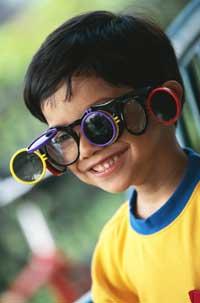Sunglasses, something more than aesthetic

The first rays of the year, together with summer clothes, remember that the time has come to remove from the drawer the swimsuit from the beach and the old sunglasses. But because they are not found or because they are completely out of fashion, you take some money (some more and some less) and go to the glasses shop to buy new ones.
Then the food begins! Glass, polycarbonate or acrylic? Black, yellowish or reddish? Photochromatic or dyed? Questions that remain unanswered. Finally, they are lost in the wide range of possibilities in the market and they acquire the favorites that are presumed, forgetting that the glasses are to protect the eyes of the ultraviolet rays.
But sunglasses should not be selected only from the aesthetic point of view. When choosing, in addition to the shape and color, you have to take into account your own activities, sensitivity to the sun and budget. Apart from the brands, remember that the structure, material and darkness of the glasses are those that protect the eyes of the ultraviolet rays.
How are sunglasses chosen?
When choosing the sunglasses, the first thing you have to take into account is the time you spend out. And it is that a person who has long been driving, on the mountain or, in general, abroad, has more need to protect the eyes of the ultraviolet rays than that which is little out.
Most glasses let between 15% and 25% of the luminosity pass, but it is the glass glasses that offer the highest optical luminosity, as well as the resistance to the stonework. However, the glass ones are quite heavy and it is recommended the use of polycarbonate for active people. The latter do not provide the same optical luminosity as those of glass, but have the advantage of being cheaper.
There are also others who pass less light, but are only recommended for mountaineers of large altitudes.

In addition to the material, take into account the color of tint of the glasses. The motif of dyeing the sunglasses is to attenuate the luminosity of the sun, but each color of dye has a different effect on the view. The colors of the glasses affect the luminosity that reaches the eyes and the ease of distinguishing colors and contrasts.
Brown, gray and green are neutral colors, so they reduce the luminosity of the sun without causing any inconvenience in distinguishing colors. With the glasses of those colors it looks very clear and the muscles of the eye do not tire so much. However, for those who carry out very different activities throughout the day, the photochromatic glasses that are darkened according to the luminosity are the most comfortable, since it is not necessary to dress or remove again and again.
Yellow glasses protect less of the light, but are adequate when there is little light. They offer a very good perception of depth and distance and are ideal for all snow sports.
The reddish ones should only be used in conditions of low luminosity since they increase visibility and contrasts. Accordingly, they are recommended for skiing or driving with fog when cloudy.
Another feature that should not be forgotten is the price of glasses. The most expensive are glass, while the cheapest are acrylic, since they offer less optical luminosity than the other two materials and can cause distortions in the image. However, they can be very suitable in exceptional cases or as replacement glasses.
Cheap glasses that can be found in ordinary stores, it is recommended not to use. These glasses reduce the luminosity of the sun, but they protect very little and sometimes nothing of the ultraviolet rays. As a result, the pupil opens more, but does not receive any protection. It does more damage than benefit to the eyes. That is why it is important to look at the protection offered by the glasses more than in the price.
What if they are not used, what?

People who do not have glasses in summer can argue that they have no problem in sight, but you have to be careful, since solar rays can produce effects in the short and long term, both in the skin and in the eyes. Like three-day burns on the skin, short-term ultraviolet rays only produce a small conjunctivitis in the eyes. At the moment it can be uncomfortable and sometimes painful, but it is cured. However, long-term effects are much more harmful, as they can cause cataracts, cancer, and degenerative diseases in the retina or muscles, among others. According to the World Health Organization, currently in the world there are 20 million people blind by cataracts, of which 20% are estimated to be due to solar rays.
Published in 7K
Buletina
Bidali zure helbide elektronikoa eta jaso asteroko buletina zure sarrera-ontzian











